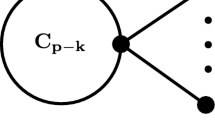Abstract
A number of studies focus on Low-Density Parity-Check (LDPC) codes to ensure reliable data communications. This study proposes an algebraic algorithm to generate strongly connected Ramanujan graphs able to provide highly symmetric LDPC codes with minimized error floor. Several Ramanujan graphs are created using GAP system software to generate a rank-efficient parity-check matrix with fixed-rate LDPC codes. We find that Ramanujan LDPC codes achieve frame error rate and bit error rate on the order of \({10}^{-5}\) and \({10}^{-6}\), respectively. Furthermore, the codes outperform QC LDPC codes and those Ramanujan LDPC codes in literature.




Similar content being viewed by others
Data Availability
All data generated or analysed during this study, including the results and conclusions, are included in this article.
Code Availability
The author used MATLAB based on the algorithm described in detail in the manuscript.
References
Cover, T. M., & Thomas, J. A. (2006). Elements of information theory, hoboken. Wiley.
Lubotzky, A., Phillips, R., & Sarnak, P. (1988). Ramanujan graphs. Combinatorica, 8(3), 261–277.
Margulis, G. A. (1982). Explicit constructions of graphs without short cycles and low density codes. Combinatorica, 2(1), 71–78.
Gallager, R. (1962). Low-density parity-check codes. IEEE Transactions on Information Theory, 8(1), 21–28.
Rosenthal, J., & Vontobel, P. O. (2000). Constructions of ldpc codes using ramanujan graphs and ideas from Margulis. In Allerton conference on communication, control and computing, Allerton.
MacKay, D. J., & Postol, M. S. (2003). Weaknesses of margulis and ramanujan-margulis low-density parity-check codes. Electronic Notes in Theoretical Computer Science, 74, 97–104.
Jo, H., & Yamasaki, Y. (2018). LPS-type Ramanujan graphs. In 2018 international symposium on information theory and its applications (ISITA).
Chiu, P. (1992). Cubic Ramanujan graphs. Combinatorica, 12(3), 275–285.
Liao, E., Yeo, E., & Nikolic, B. (2004). Low-density parity-check code constructions for hardware implementation. In 2004 IEEE international conference on communications (IEEE Cat. No.04CH37577), Paris.
Asvadi, R., Banihashemi, A. H., & Ahmadian-Attari, M. (2011). Lowering the error floor of LDPC codes using cyclic liftings. IEEE Transactions on Information Theory, 57(4), 2213–2224.
Kim, S.-R., & Shin, D.-J. (2013). Lowering error floors of systematic LDPC codes using data shortening. IEEE Communications Letters, 17(12), 2348–2351.
Tolouei, S., & Banihashemi, A. H. (2014). Lowering the error floor of LDPC codes using multi-step quantization. IEEE Communications Letters, 18(1), 86–89.
Lee, H.-C., Chou, P.-C., & Ueng, Y.-L. (2018). An effective low-complexity error-floor lowering technique for high-rate QC-LDPC codes. IEEE Communications Letters, 22(10), 1988–1991.
Soltanpur, C., Ghamari, M., Heravi, B. M., & Zare, F. (2017). Lowering error floors by concatenation of low-density parity-check and array code. International Journal of Mathematical and Computational Sciences, 11(4), 154–158.
Karimi, B., & Banihashemi, A. H. (2021). Construction of irregular protograph-based QC-LDPC codes with low error floor. IEEE Transactions on Communications, 69(1), 1.
Zhang, G., Hu, Y., Fang, Y., & Wang, J. (2019). Constructions of type-II QC-LDPC codes with girth eight from sidon sequence. IEEE Transactions on Communications, 67(6), 3865–3878.
Zhang, G., Hu, Y., Ren, D., Liu, Y., & Yang, Y. (2020). Type-II QC-LDPC codes from multiplicative subgroup of prime field. IEEE Access, 8, 142459–142467.
Kaufman, T., & Lubotzky, A. (2012). Edge transitive Ramanujan graphs and symmetric LDPC good codes. In R. Ann (Ed.), STOC ’12: Proceedings of the forty-fourth annual ACM symposium on theory of computing. New York: Springer.
GAP- Groups, Algorithms, Programming—a system for computational discrete algebra (2020). Retrived 2020, from https://www.gap-system.org/index.html.
Kaufman, T., & Lubotzky, A.. (2011). Edge transitive ramanujan graphs and highly symmetric LDPC good codes. Retrieved from https://arxiv.org/abs/1108.2960.
Koetz, M. T. (2005). Algebraic constructions of low-density parity check codes. The University of Nebraska.
Lubotzky, A. (2012). Expander graphs in pure and applied mathematics. Bulletin of the American Mathematical Society, 49(1), 113–162.
Mohar, B. (1989). Isoperimetric numbers of graphs. Journal of Combinatorial Theory, Series B, 47(3), 274–291.
Kaufman, T., & Wigderson, A. (2016). Symmetric LDPC codes and local testing. Combinatorica, 36, 91–120.
Davidoff, G., Sarnak, P., & Valette, A. (2003). Elementary number theory, group theory, and ramanujan graphs. Cambridge University Press.
Funding
No funding was received.
Author information
Authors and Affiliations
Corresponding author
Ethics declarations
Conflict of interest
The authors declare that they have no confict of interest.
Additional information
Publisher's Note
Springer Nature remains neutral with regard to jurisdictional claims in published maps and institutional affiliations.
Rights and permissions
About this article
Cite this article
Al-Hamdani, H., Almamori, A. & Mohan, S. Strongly Connected Ramanujan Graphs for Highly Symmetric LDPC Codes. Wireless Pers Commun 125, 2463–2475 (2022). https://doi.org/10.1007/s11277-022-09668-0
Accepted:
Published:
Issue Date:
DOI: https://doi.org/10.1007/s11277-022-09668-0




